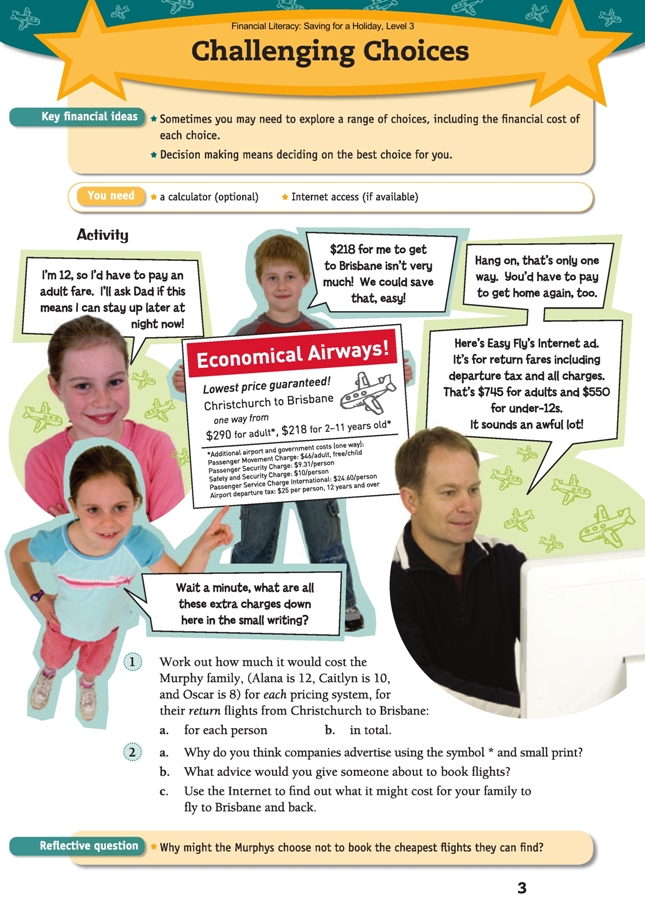This is a level 3 number activity from the Figure It Out series. It relates to Stage 6 of the Number Framework.
A PDF of the student activity is included.
Click on the image to enlarge it. Click again to close. Download PDF (3148 KB)
use additive strategies to calculate costs
Number Framework Links
Students could use stage 6 strategies to work out the cost of the flights. Students at lower stages will need access to a calculator.
FIO, Level 3, Financial Literacy: Saving for a Holiday, Challenging Choices, page 3
Internet access (if available)
Financial understanding
In this activity, students use advertisements to work out the cost of flying the family to Brisbane and back and compare the choices available. They will need to read and understand a range of information presented in a variety of forms.
Before the students start, familiarise them with the activity by asking questions such as: What do travel companies mean when they use the words “one way”, “single”, or “return”?
What do you think some of the charges outlined in the ad might be for? (People to scan you and your luggage to make sure that you’re not taking anything dangerous onto the plane, airport facilities including carparks, lounges, toilets, and baggage carousels)
How old do you think a person should be before they are called an adult?
Do you think it’s fair that airlines charge 12-year-olds the full adult fare? (Answers may include yes, because they take up the same seat and luggage room on the plane, or no, because they don’t have an adult’s earning capacity, so they shouldn’t have to pay as much, and they may be lighter than most adults.)
After the activity, encourage your students to look for travel or product advertisements in newspapers, magazines, or on the Internet. They may find ones that seek to “hook” the reader by offering what looks like a really good deal on
first glance but that have terms and conditions that are less attractive on further investigation (which the advertisers are hoping the reader won’t do!). For example, an advertised child’s fare may be much closer to the full adult fare by the time small-print surcharges and taxes are included. Give the students the opportunity to share their examples with the class.
Students with Internet access will find lots of examples if they enter “misleading advertising” into a search engine.
Social Sciences Links
Achievement objectives:
• Understand how people make choices to meet their needs and wants (Social Studies, level 2)
Students could discuss:
– What is impacting on choices the family have to make?
– Where have they got the information from?
– What other things may impact on the choices they will make?
• Understand how people make decisions about access to and use of resources (Social Studies, level 3)
Other Cross-curricular Links
English achievement objectives:
• Purposes and audiences: Show a developing understanding of how texts are shaped for different purposes and audiences (Listening, Reading, and Viewing, level 3)
• Language features: Use language features appropriately, showing a developing understanding of their effects (Speaking, Writing, and Presenting, level 3)
Students could explore the language used in advertisements that aim to persuade you to buy something and make a collage or list of examples they find.
They could write their own advertisement to persuade their relatives to buy a good or service that they can produce, such as dog walking, dishwasher loading, computer game tutoring, or baby-brother minding.
Answers to Activity
1. a. Economical Airways (based on the extra costs from Brisbane to Christchurch: $809.82 each for Dad and Alana ($290 x 2 [to cover return] + $46 x 2 + $9.31 x 2 + $10 x 2 + $24.60 x 2 + $25 x 2 = $809.82 per person) and $523.82 each for Caitlyn and Oscar ($218 x 2 [to cover return] + $9.31 x 2 + $10 x 2 + $24.60 x 2 = $523.82 per person)
Easy Fly: $745 each for Dad and Alana and $550 each for Caitlyn and Oscar
b. Based on a, $2,667.28 ($809.82 x 2 + $523.82 x 2) for Economical Airlines and
$2,590 ($745 x 2 + $550 x 2) for Easy Fly
2. a. Answers will vary. For example, a company may hope that people won’t read the small print and will think the main price advertised is a better deal than that in another advertisement that quotes the full price. They want to catch your attention with what looks like a really good deal and make you want whatever they’re advertising.
b. Answers will vary. You may advise the person to check the small print for hidden
costs, add in any extra costs, and compare that total to the totals in other advertisements for the same product or service; compare departure and arrival times and weigh them up against any extra costs; shop around to see if you can find a better deal on the Internet or at a travel agent or with a competing airline; be aware that prices may be higher during school holidays and weekends. Note that in the examples in the activity, the Easy Fly prices are more expensive for children but less expensive for adults than the Economical Airways prices – so which prices are cheaper overall would depend on how many adults and how many children you are buying tickets for.
c. Costs will vary.
Reflective question
Answers will vary. The cheapest flights might mean departing and/or arriving at inconvenient times (such as 6 a.m.!) or dates; the luggage allowance may be less.
